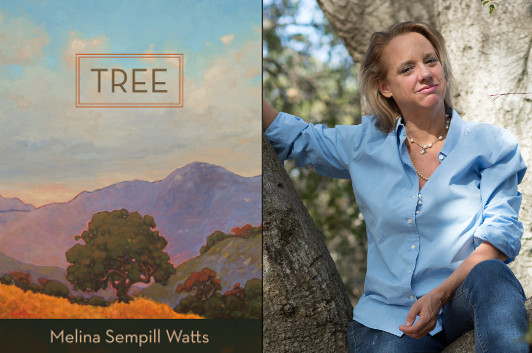Melina Sempill Watts: The Roots of Tree

photo: Elizabeth Jebef, Eyebright Studios
Every author faces a challenge in coming to understand their characters, but Melina Sempill Watts set herself a particularly tough task, in that the protagonist of Tree is, well, a tree, named Tree. Watts has to figure out the perspective of a character whose ideal lifespan makes human life seem brief by comparison; she has to figure out whether trees can communicate with other lifeforms and if so how; she has to figure out how drama and character momentum work when your main point of view character is literally rooted to the ground… Like I say, a significant challenge! In this essay, Watts explains what makes her feel passionately enough about the subject to take that challenge on.
Babies are made—most times—from love. What are books made from?
In the case of Tree, the intellectual grounding of the novel’s world came from two major strands. The emotional center of the book stems from a secret.
The first strand stems from my lifelong passion for California history, reverence for Chumash culture, a crush on the Californio era and from pieces of my own childhood, when I watched the growth of suburbia sneak up and over the green hills in the Santa Monica Mountains.
The second strand came from focusing on biology and ecological history: how did the ecosystems of Southern California transform over time, how did different cultures push plant and animal communities into new forms? The most radical transition, initially, was to grasslands, when species coming from Spain and other European communities took over. Research looking at what plants were used in the adobe bricks from the oldest European buildings on the Western side of the United States, shows that transition was nearly immediate.
23 October 2017 | guest authors |
Sonia Taitz’s American Dream

photo: H&H Photographers
I first met Sonia Taitz back in 2012, when we recorded an episode of Life Stories to discuss her memoir, The Watchmaker’s Daughter. Since then, she’s been focusing on fiction, and her latest novel, Great with Child, actually explores some of the same psychological and emotional themes that she previously wrote about in autobiographical mode. But, here, let Sonia explain it…
The heroine of Great with Child is the daughter of two newcomers to America. Driven by her parent’s immigrant ambition, Abigail Thomas becomes a blindly competitive associate at a prestigious law firm. Her background provides a baseline for her personal and professional evolution through the course of the book. The catalyst for change is her accidental pregnancy, which throws all her certainties into question. My own trajectory led me from law to writing—and to writing this book in particular.
I’ve always proudly defined myself as the daughter of immigrants. And not just in the vague, melting pot American way, but as a first-generation child, born of refugees of World War II. My parents came out of war-torn Europe and sailed the ocean until they saw the Statue of Liberty. That statue meant everything to them, as did its poem, written by Emma Lazarus (also born of immigrants): “Give me your tired, your poor, your huddled masses yearning to breathe free.”
They were tired, they were poor; they had been huddled and incarcerated. Now, they were leaving the Old World to embark on the New. In their eyes, I was destined to become the embodiment of their American Dream, with all the security that entailed. Loving them as I did, I faithfully wanted whatever they wanted. It would be years before I could differentiate my wishes from theirs—or even knew what my own wishes were.
24 April 2017 | guest authors |

 Our Endless and Proper Work is my new book with Belt Publishing about starting (and sticking to) a productive writing practice.
Our Endless and Proper Work is my new book with Belt Publishing about starting (and sticking to) a productive writing practice. 
